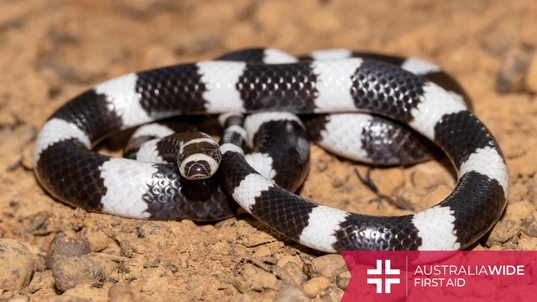The Australian Bandy Bandy Snake

Bites and Stings

The Bandy Bandy is a venomous, nocturnal snake of which there are five known species. Covered in striking black and white stripes, the Bandy Bandy is one of Australia's most iconic reptiles.
The Bandy Bandy (Vermicella annulata), also known as the Hoop snake, is a venomous, nocturnal snake of which there are five known species. These species are native to Australia and are most commonly found in north-eastern Australia. Since the Bandy Bandy is venomous, it is important to learn about and be familiar with its characteristics and preferred habitat, as well as snake bite first aid. We also cover snake bite first aid in our general and childcare first aid courses: We have training locations in every state, capital city, and major town in Australia. Head to our website to find and enrol in a first aid course near you today.Appearance
There are 5 species of Bandy Bandy, which generally have the following identifying characteristics:- Smooth scaled, glossy snake with black and white rings that continue right around the body
- Adults reach from 50-80cm in length
- Small head with a black, rounded snout and small eyes
Habitat
The Bandy Bandy can inhabit a wide range of habitats spanning from coastal forest and woodland to scrubland, mulga, and outback desert. However, they are not an aquatic snake species and so will avoid large bodies of water. In their habitats, they are most commonly found burrowing underground under rocks, logs, and other natural debris.Diet
The diet of the Bandy Bandy snake is very interesting, as they feed almost exclusively on a group of snakes called Blind snakes. Blind snakes are poor in vision and small in size, with adults usually reaching 10-15cm in length. The Bandy Bandy generally emerges at night to forage, especially after rain.Danger
The Bandy bandy has a couple different defence strategies, including 'flicker fusion', wherein it moves very quickly in dim lighting to confuse predators. Unfortunately, flicker fusion only works at night and if the Bandy bandy can make the frequency of its movements faster than the predator's eyes can perceive. To ward off predators, the Bandy Bandy also sometimes twists itself into hops to make itself taller, wider, and to show off its bright colours. When it comes to humans, the Bandy Bandy is generally considered harmless due to its inoffensive nature and small mouth, which is unlikely to release much venom. The venom itself is weak and generally only causes localised symptoms around the bite site. In saying that, it can be difficult to positively differentiate one snake species from another, so all snake bites should be treated as a medical emergency. If you or someone you are with is bitten by a snake, call Triple Zero (000) for emergency services and apply a pressure bandage as part of the Pressure Immobilisation Technique.Final Thoughts
The Bandy Bandy is a nocturnal burrowing snake that is locally distributed throughout most of north-eastern Australia. Though it is only weakly venomous, all snake bites should be treated as a medical emergency with the Pressure Immobilisation Technique until proven otherwise by a doctor at a hospital. To avoid a snake bite, never attempt to approach, capture, or kill a snake. If you need a snake relocated from your property, contact a professional snake catcher, instead. For more hands-on experience with identifying and treating snake bites, head to the home page on our website and book an HLTAID011 or HLTAID012 course near you.
Originally published at
https://www.australiawidefirstaid.com.au/resources/bandy-bandy
as part of the Australia Wide First Aid Articles Library









